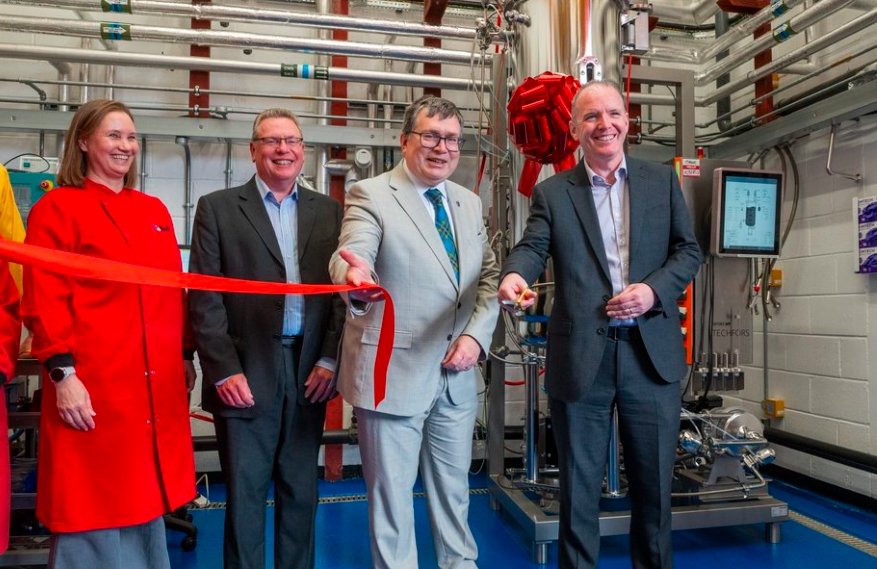A sleek steel tank nestled inside Heriot-Watt University might not look like much from the outside. But inside Scotland’s first open-access 300-litre fermenter, an industrial biotech transformation is already bubbling to life.
The new kit—funded with £847,000 from Scottish Enterprise—marks a giant leap for FlexBIO, the pilot-scale facility at the Industrial Biotechnology Innovation Centre (IBioIC). For Scotland’s startups, it’s the bridge between petri dish and full production.
Why This Fermenter Is More Than Just a Fancy Tank
It’s not the size that makes this fermenter a big deal—it’s what it can do. While technically a 300-litre vessel, the working volume is around 200 litres. That extra space? It’s crucial for foaming and airflow.
FlexBIO’s scale-up lead Neil Renault explains how they packed versatility into every inch. You’ve got a double Rushton impeller for high-speed mixing. A pitch blade impeller if your microbes need a gentler touch.
One small but mighty feature: dual sensors for pH and oxygen.
So if a sensor fails?
No panic. No ruined batch.
This isn’t just a test tube on steroids. It’s a near-commercial system. Extraction. Purification. Monitoring gases in and out. Cleaning itself with the right chemicals. It’s practically a biotech factory in miniature.

From Coffee Cups to Kegs: Scale Just Got Real
Before this, FlexBIO’s limit was 30 litres. Enough for proof-of-concept work, sure, but not quite enough to wow investors or get customers testing product.
Now? They can pump out 300 litres—real batches, real material, real results.
One-sentence paragraph here.
That jump in size means more than just bigger quantities. It also unlocks the tricky, often-overlooked part: downstream processing. The sticky bit where you extract and purify your product, which often eats up more time and money than fermentation itself.
And that’s the beauty of this setup. It supports both ends of the process:
-
Fermentation scale-up (from 2 to 300 litres)
-
Integrated extraction and purification testing
-
Gas flow control and analysis
-
Real-world risk mitigation
-
Automatic cleaning cycles for safety and efficiency
Renault puts it plainly: “You don’t just scale up and hope. You plan. You test. You adapt.”
What Can You Actually Make With It? Pretty Much Anything Microbial
The new fermenter isn’t picky. That’s by design.
Whether you’re working with yeast, bacteria, or something exotic, the system can handle it. Plus, it’s feedstock-flexible—so it’s ready for whatever researchers throw at it.
Let’s be real: the microbes people are working with these days aren’t your garden-variety strains. They’re tweaked, tailored, sometimes downright temperamental.
So adaptability isn’t a nice-to-have. It’s essential.
One-line paragraph, again.
And that flexibility stretches across projects. Some companies arrive at square one. Others are already running 30-litre systems elsewhere and want to test at the next level.
Either way, the fermenter helps them answer the million-pound question: can this scale?
Training a Bio-Literate Workforce—One Drum at a Time
It’s not just about companies. It’s also about people.
This fermenter changes the game for training. Forget shaking flasks—this is drum handling, cleaning cycles, gas regulation. It’s biotech at industrial scale.
And for Scotland, that matters. You can’t grow a biotech sector without skilled folks to run it.
This tool builds confidence. It teaches safety. It turns students into technicians and PhDs into process engineers.
Table: How the Fermenter Compares
| Feature | Previous FlexBIO Limit | New Fermenter (300L) |
|---|---|---|
| Max Working Volume | 30 litres | 200 litres |
| Downstream Processing | Limited | Full commercial mimic |
| Feedstock Compatibility | Moderate | High |
| Cleaning System | Manual | CIP (Automated) |
| Oxygen/Nitrogen Control | Basic | Mass Flow Control |
And then there’s retention. The fermenter gives Scottish companies a reason to stay in Scotland. No need to outsource scale-up overseas. The infrastructure’s here—so the innovation can stay here too.
Partners in Progress: Academia Meets Industry
Good ideas often start in university labs. But scaling them into something real? That’s where FlexBIO steps in.
They’re not just a facility—they’re collaborators. They sit in on grant meetings. Offer advice. Spot problems before they snowball.
It’s early involvement that builds trust.
One line. Just to keep things light.
And the partnerships aren’t just local. FlexBIO’s joined the Pilots4U COPILOT network, connecting them with scale-up sites across the UK. So if they can’t help directly, they know who can.
What’s Next? A Busy Summer and Bigger Ambitions
The system’s been commissioned. Training is ongoing. And the first commercial run is already booked for this summer.
That company? One they’ve worked with before—just now at a much larger scale.
Everything’s coming together.
Final tweaks to safety protocols. Procedure refinement. Some trial and error, sure. But FlexBIO’s nearly there.
And once the doors fully open, Scotland’s industrial biotech scene won’t be the same.


















